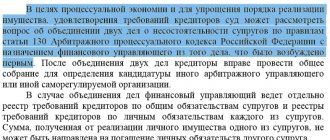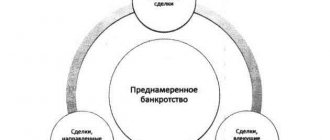CJSC (closed joint stock company) are legal entities in which the distribution of shares is made exclusively within a specified group of persons. Just like other enterprises, a closed joint-stock company may be subject to bankruptcy proceedings. The term denotes the financial insolvency of an organization that is unable to fulfill its obligations to creditors.
In difficult situations, initiating the bankruptcy process of a closed joint stock company is the only way out, allowing you to complete the case without lawsuits and associated costs. The new status of the enterprise is formalized by a court decision recording the fact of liquidation of the legal entity.
Signs
The grounds and signs of business insolvency are determined by Federal Law No. 127, as well as Art. 25. Civil Code of the Russian Federation. It states here that a closed joint-stock company is declared bankrupt if it is unable to meet the current requirements of creditors and bear budgetary obligations by transferring the necessary payments.
There are two types of bankruptcy: forced, where the reason is detected violations, and voluntary, when the participants themselves state the impossibility of further business. Regardless of the form, a case is initiated if several signs are present, which include:
- Failure to fulfill financial or property claims of creditors within 3 months;
- Inability to fulfill obligations to the tax service and extra-budgetary funds;
- Negative balance, excess of the amount of debt obligations over the total value of the JSC’s property;
- The amount of debt exceeds the threshold of 100 thousand rubles.
Identification of at least 2 of these conditions provides grounds for declaring the organization bankrupt. During this period, the CJSC is deprived of the right to reduce its authorized capital, alienate issue documents, and transfer dividend payments to shareholders.
Additional information about bankruptcy of JSC
Despite the fact that in some cases the initiators of bankruptcy are called private individuals (owners of a business that may soon be declared bankrupt), in most cases it is the creditors who are interested in this.
If a creditor has already financed a company or JSC once (loaned money), then he will want to return not only the amount of the debt, but also the interest. This can be done in court, but then you will have to hire a lawyer, write an application, collect documentation and deal with other bureaucratic procedures.
Stages of bankruptcy of a closed company
Insolvency proceedings are carried out in the Arbitration Court at the request of the owners of the closed joint stock company, creditors, and state representatives. When drawing up the document, indicate:
- The name of the Arbitration Court acting as the addressee of the application;
- The amount of monetary claims of creditors;
- The volume of debt for mandatory payments;
- Total amount of debt;
- Information about the company's property;
- Argumentation of the impossibility of the CJSC fulfilling its obligations;
- The amount assigned to the arbitration manager.
The application is accompanied by the Charter of the company, extracts from the Tax Office, and the Unified State Register of Legal Entities.
The insolvency of a closed joint stock company is declared in several stages, the last of which is the complete liquidation of the company. It may be preceded by:
Observation
At this stage, all operations aimed at collecting funds from the organization are stopped, and the company no longer bears debt obligations. At the same time, the right of shareholders to freely dispose of securities is suspended. Depending on the situation, the observation stage has several options for continuation:
Financial recovery
The measure involves restoring the payment capacity of the company using funds received from the founder, shareholder or third parties interested in the successful resolution of the crisis. The decision to apply recovery is made by the Arbitration Court, preceded by a general meeting of creditors. Here we consider a petition for reorganization, which can be initiated by the founders, authorized bodies, or debt holders of the organization.
The maximum duration of the stage is 2 years, as a rule, it includes:
- Attracting a team of competent managers;
- Sale of part of the property;
- Disposal of unprofitable assets;
- Repurposing of activities;
- Information campaign (advertising).
As a result, the court terminates the bankruptcy case of the closed joint stock company, or resorts to other methods of resolving the situation.
External control
According to the law, the stage is carried out within 18 months, and regulation is carried out by the Arbitration Court. To begin with, a meeting of creditors is held, where issues of the financial rehabilitation of the company and the gradual repayment of debt obligations are put on the agenda. An external manager appointed by creditors is responsible for the implementation of the program. The plan itself includes:
- Restoring the ability of the company to pay debts;
- Ways to regain financial solvency;
- Costs of an external management program.
- The stage cancels the authority of the head of the enterprise, the claims of creditors and transfers all financial actions to a procedural format, where the Federal Law “On Bankruptcy” plays a key role in decision-making.
Bankruptcy proceedings
Current legislation allocates 6 months to this stage, obliging the company to repay debts to creditors. The stage is step-by-step in nature, consisting of:
- Inventory of JSC property;
- Its valuation in monetary terms;
- Sales of property assets;
- Settlement of obligations.
An important feature of bankruptcy proceedings is the termination of a trade secret when the financial situation in the closed joint-stock company becomes public.
Successful completion of all steps makes complete liquidation of the enterprise possible.
On declaring FSUE "GUVO" insolvent (bankrupt) and opening bankruptcy proceedings
The operative part of the decision was announced on December 14, 2010. The full text of the decision was made on December 21, 2010.
when keeping the minutes of the court session by the secretary of the court session, Krasilnikova E.V.
A representative of the authorized body made an oral request to declare a break in the court session to hold the first meeting of creditors.
From the explanations of the temporary manager it follows that the first meeting was convened by him and held twice on November 29, 2010 and December 6, 2010.
FSUE "GUVO" is insolvent and does not have the ability to regain solvency and continue its authorized activities.
The Debtor's manager explained that the company has not been conducting its main activities since December 31, 2009, and it does not seem likely to repay the debt.
From the materials presented with the report, it follows that the temporary manager fulfilled the requirements of Article 67 of the Bankruptcy Law.
Refuse the Federal Tax Service to satisfy requests for a break in the court hearing and to postpone the consideration of the case.
Recognize FSUE "GUVO" insolvent (insolvent (bankrupt)) and open bankruptcy proceedings against the Debtor for a period of 6 months.
Entrust the fulfillment of the obligations of the bankruptcy trustee of the FSUE "GUVO" to the temporary manager Lena Aleksandrovna Pavlova.
An appeal against the decision may be filed with the Thirteenth Arbitration Court of Appeal within a month. from the date of the decision.
Settlement agreement
At each stage from filing an application to bankruptcy proceedings, the parties can enter into a settlement agreement, agreeing on an out-of-court resolution of controversial issues. In this case, the Arbitration Court terminates the insolvency case, the company pays off its debts and returns to its current activities.
The parties to the settlement agreement are the direct debtor and bankruptcy creditors; in some cases, a guarantor who has assumed certain rights and obligations becomes a participant. This could be the new owner of the business who is planning to restart its operations.
To conclude a settlement agreement, a decision of the majority of bankruptcy creditors and representatives of government agencies, adopted at a general meeting, is required.
The agreement becomes valid only with a positive vote of all creditors entitled to the obligations secured by the property pledge.
The representative of the debtor is determined depending on the stage of the bankruptcy procedure, during supervision it is a temporary manager, during external management - an external manager, during financial recovery - a financial manager, at the stage of bankruptcy proceedings - a bankruptcy trustee.
The document is drawn up in writing and must contain the signatures of all parties, as well as a clause indicating the amount, procedure and timing of repayment of the CJSC’s debt. Participants have access to any options for repaying obligations provided by law:
- Payment of compensation;
- Debt forgiveness;
- Debt restructuring;
- Novation of a debt (its transfer to another quality or transfer to another person).
The approval of a settlement agreement in the event of bankruptcy of a closed joint-stock company is carried out by the Arbitration Court, after which it enters into legal force, preventing unilateral withdrawal from the agreement.
Customer Reviews
our clients
Moscow, Gamsonovsky lane, building 2, building 1, office 314
The procedure for declaring a Joint Stock Company bankrupt is the optimal method for eliminating debt obligations. The process is quite complex and requires time. Declaring bankruptcy is the only sure way to exit a business legally.
Dear readers! The article talks about typical ways to resolve legal issues, but each case is individual. If you want to find out how to solve your particular problem , contact a consultant:
+7 (Saint Petersburg)
APPLICATIONS AND CALLS ARE ACCEPTED 24/7 and 7 days a week.
It's fast and FREE !
At the observation stage, it is possible to assess whether there is a chance to restore the financial situation and continue operations.
At the next stage, the arbitration court sets a period for financial recovery. As part of this stage, opportunities and measures should be sought to restore the solvency of the joint-stock company.
External management at this stage is initiated by creditors. Responsibility for implementing rehabilitation measures rests with the manager of the enterprise.
It should be borne in mind that at any stage the process can be turned into a peaceful channel. With the consent of the creditor, the bankruptcy procedure can be terminated.
When the procedure is completed and the JSC is declared bankrupt, bankruptcy proceedings are carried out. Settlements with creditors are entrusted to the bankruptcy trustee. At this point, business activity is considered completed.
Considering the complexity and versatility of the process of declaring bankruptcy, it is advisable to entrust it to professionals.
Shares and shareholders after the bankruptcy of the JSC
According to the provisions of Federal Law No. 208, which regulates the activities of joint-stock companies, the liquidation of a closed joint-stock company entails the complete cessation of its activities. The rights and obligations of the owners are not transferred to other persons, and the securities become invalid, which entails corresponding financial losses for their owners.
At the same time, legal practice knows many situations when, after settlement of all debt obligations, part of the property remains unsold. Most often this happens during the voluntary initiation of bankruptcy proceedings. The balance is distributed in a clear sequence:
- Shareholders with the right to repurchase shares are the first to receive shares;
- Then shareholders who own preferred securities;
- Lastly, funds are credited to holders of common shares.
Along with rights, shareholders bear responsibility, especially if the proceeds from the sale of the JSC's property are not enough to pay off debts. In this case, the Arbitration Court is authorized to assign subsidiary liability to the manager .
In practice, this means repaying the debt at the expense of the personal property of the shareholders of the CJSC. The property subject to seizure and sale is determined by the Court. Such decisions are made in 50% of cases, so each party to the process can count on success.
Our bankruptcy specialists:
General Director of Forseti Legal Bureau LLC, Candidate of Legal Sciences. Specialization in all areas of civil law, administrative offenses, defense at all stages of the arbitration process.
Leading lawyer at Forseti Legal Bureau LLC, specialist in the field of contract and arbitration law. Main areas of activity: challenging the right of ownership of real estate, invalidating transactions, appealing acts, decisions and actions of public bodies and officials. Professional direction of development – corporate law.
Lawyer at Forseti Legal Bureau LLC. Specializes in the field of state registration and liquidation of legal entities/individual entrepreneurs, contract law, administrative cases.
|
Lawyer at Forseti Legal Bureau LLC. Specializes in the field of contract law, administrative proceedings, civil and arbitration proceedings, legal support of company activities.
|
Assistant lawyer at Forseti Legal Bureau LLC. Specializes in supporting bankruptcy procedures in accordance with Federal Law No. 127 “On Insolvency (Bankruptcy)”.
Consequences
A court decision on the insolvency of a closed joint-stock company entails a complex of consequences, with traditionally negative and positive effects being distinguished. In the first case, these are financial losses, dismissal of personnel, cessation of business activities, which has a bad effect on the general state of the economy.
At the same time, positive results are also observed, including the repayment of debt, the removal of incompetent management, and the opportunity to start with a clean slate without the burden of past debts.
The negative or positive effect of bankruptcy depends on the status of the parties to the process. Thus, in the case of liquidation of a closed joint stock company, shareholders may bear subsidiary liability based on their participation in the company’s activities, paying certain compensation to creditors.
At the same time, this creates an additional probability for the recipients of payments to receive their money, even if they are among the 4th priority creditors.
Main factors leading to bankruptcy
When creating a joint stock company, there are always certain risks associated with the activities carried out. The bankruptcy process may be associated with the following factors: objective – may depend on the political and economic situations in the country; subjective - depend on management and the degree of importance of the decisions they make.
The most common subjective reasons leading to bankruptcy of a joint stock company are as follows:
- Unreasonably large financial costs.
- Significant reduction in production volumes.
- Low quality of products (services provided).
- Growing debt outpacing the level of regular payments.
- Low level of technical equipment in production or the presence of imperfect technologies.
- The presence of financial investments that do not produce effective results.
- Low profitability of products on the market and lag behind demand.
Nuances of insolvency of a closed joint stock company
The insolvency of closed joint stock companies is determined in accordance with the general rules of Russian bankruptcy legislation, however, in the case of this form of ownership there are some nuances:
- Insolvency can be caused by the action or inaction of shareholders, which makes them liable to creditors. Funds seized by the court are included in the total bankruptcy estate;
- Detected signs of financial insolvency automatically exclude the deduction of current dividends to shareholders, the alienation of issue-grade securities and the reduction of the amount of the authorized capital;
- The bankruptcy regulations of closed joint stock companies apply to their subsidiaries, the insolvency of which imposes subsidiary liability on the central company. In this case, the shareholders of the subsidiary have the right to expect compensation for losses.
The main goal of all actions taken in relation to the company and its shareholders is to protect the interests of creditors, and therefore to minimize the costs of the enterprise when all money and property are used as a settlement fund for debts.
In bankruptcy court practice, cases of liquidation of a closed joint stock company are considered one of the most difficult. Regardless of the reasons for insolvency, its voluntary or forced nature, the process is carried out in several stages, the last of which is the final termination of the enterprise.
Often it becomes the only way to correct the current situation, when investors can count on the return of at least part of the money. In turn, for shareholders, bankruptcy most often becomes a difficult ordeal, canceling the value of securities and (if the Arbitration Court decides) imposing debt obligations.
Where does it all begin?
Bankruptcy of a JSC can be voluntary or forced. In the first case, an application for recognition of financial insolvency is submitted to the Arbitration Court by the head of the organization. In the second - his lenders. This cannot be done at any time, not at the momentary desire of the manager (founder) and not in the case when the creditor, harboring a grudge, decides to ruin his business partner. There must be valid reasons for filing an application.
The law recognizes as such debt in an amount exceeding 100,000 rubles and late payments equal to three months. Documents confirming financial insolvency must be attached to the application.
In this case, the fact who went to court first is of great importance, since he is given the right to choose an arbitration manager. A lot depends on the new manager, for example, the ability to save the business or sell the company’s property at a better price, and therefore earn more money.










